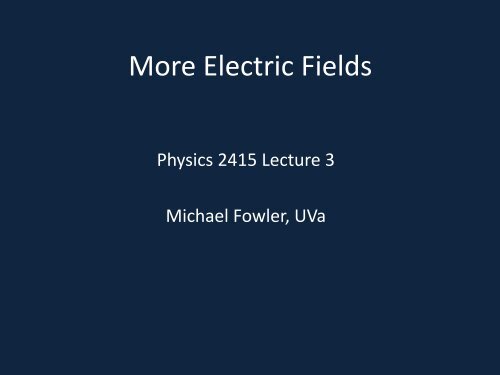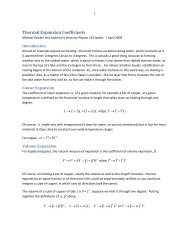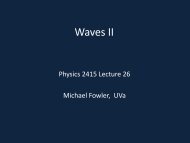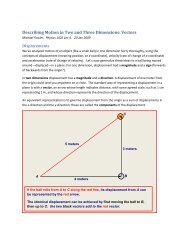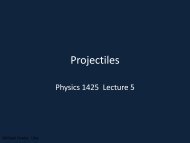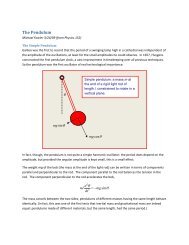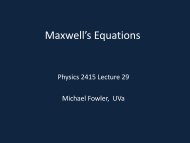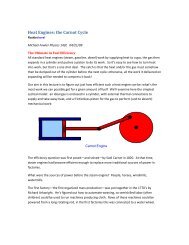R - Galileo and Einstein
R - Galileo and Einstein
R - Galileo and Einstein
Create successful ePaper yourself
Turn your PDF publications into a flip-book with our unique Google optimized e-Paper software.
More Electric Fields<br />
Physics 2415 Lecture 3<br />
Michael Fowler, UVa
Today’s Topics<br />
• Continuous charge distributions: line of charge<br />
• Visualizing the field: lines of force<br />
• Electron moving in a field<br />
• Electric dipoles
Superposition<br />
• The total electric force on a charge Q 3 from<br />
two charges Q 1 , Q 2 is the vector sum of the<br />
forces from the charges found separately.<br />
Q 1<br />
Q 2<br />
Q 3<br />
F<br />
<br />
2 3 23<br />
23 2<br />
r23<br />
F<br />
kQ Q rˆ<br />
<br />
F<br />
kQ Q rˆ<br />
1 3 13<br />
13 2<br />
r13<br />
on<br />
Q<br />
total 3<br />
Sounds trivial—but superposition isn’t true for nuclear forces!
Field from Two Equal Charges<br />
• Two charges Q are placed on the y-axis, equal distances d<br />
from the origin up <strong>and</strong> down. What is the electric field at a<br />
point P on the x-axis, <strong>and</strong> where is its maximum value?<br />
y-axis<br />
x-axis<br />
Q<br />
d<br />
d<br />
Q<br />
x<br />
r<br />
<br />
P<br />
<br />
E<br />
E total<br />
<br />
kQrˆ<br />
r<br />
upper charge 2<br />
• Anywhere on the axis, the field is along the axis, <strong>and</strong> has value<br />
E<br />
2 2 2<br />
kQ cos kQx <br />
kQx .<br />
r 2 r 3 2 2<br />
x d<br />
3/2
Field from a Uniform Line of Charge<br />
• What’s the electric field at a • q<br />
point P distance R from a very<br />
long line of charge, say C/m?<br />
• Take the wire along the z-axis in<br />
3D Cartesian coordinates,we’ll<br />
find the field at a point P,<br />
distance R from the wire, in the<br />
(x,y) plane.<br />
• The strategy is to find the field<br />
z dE from a bit dz of the wire,<br />
then do an integral over the<br />
whole wire.<br />
dE<br />
in<br />
<br />
Rsec<br />
P<br />
<br />
R<br />
from charge<br />
d Rtan<br />
<br />
z-axis<br />
dz<br />
R tan<br />
O
Field from a Uniform Line of Charge<br />
• The strategy is to find the field<br />
z from a bit dz of the wire, then<br />
do an integral over the whole<br />
wire.<br />
kdq kdz kd R<br />
tan<br />
kd<br />
dE <br />
2 2 2 2<br />
r r R sec R<br />
• For an infinite wire, the net field<br />
must be directly away from the<br />
wire, so multiply by cos <strong>and</strong><br />
integrate over all z :<br />
E <br />
k<br />
R<br />
/2<br />
<br />
<br />
/2<br />
cosd<br />
<br />
2k<br />
R<br />
dE<br />
• q<br />
dE<br />
in<br />
r<br />
Rsec<br />
<br />
P<br />
<br />
R<br />
from charge<br />
d Rtan<br />
<br />
z-axis<br />
dz<br />
z<br />
Rtan<br />
O
Electric Field from a Plane of Charge<br />
• It’s worth drawing the field<br />
lines to emphasize that the<br />
electric field from a<br />
uniformly charged plane is<br />
directly outward from the<br />
plane.<br />
• Charge density:<br />
• a<br />
Coulombs/m 2<br />
E<br />
<br />
2k<br />
<br />
<br />
2<br />
0
Field for Two Oppositely Charged Planes<br />
• a<br />
E <br />
0<br />
+ =<br />
Superpose the field lines from the negatively charged plate on the parallel positively<br />
charged one, <strong>and</strong> you’ll see the total field is double in the space between the plates,<br />
but exactly zero outside the plates.
Motion of an Electron Between Two<br />
Oppositely Charged Plates<br />
• Two uniformly charged plates<br />
with equal but opposite<br />
charge generate a uniform<br />
electric field between them,<br />
except near the edges.<br />
• An electron entering this<br />
region will feel a constant<br />
downward force, <strong>and</strong> act<br />
exactly like a projectile under<br />
gravity, with downward<br />
acceleration eE/m.<br />
• a<br />
E<br />
<br />
<br />
<br />
<br />
2 2 <br />
0 0 0
Field of Two Equal Charges off the Axis<br />
• Close to one of the<br />
charges, its own field<br />
dominates. On the axis<br />
between them, the field is<br />
along the axis.<br />
• To find the field elsewhere,<br />
we must add the two field<br />
vectors, <strong>and</strong> so can trace<br />
lines of force.<br />
• a
Field Lines for Two Equal Charges<br />
• The lines are more<br />
crowded where the<br />
field is stronger, but at<br />
the central point there<br />
is zero field strength—<br />
the vertical lines go into<br />
that point, the<br />
horizontal lines come<br />
out.
Field on Axis from Two Opposite Charges<br />
• This is a dipole: the analysis is just like the two equal charges case:<br />
y-axis<br />
x-axis<br />
Q<br />
d<br />
d<br />
-Q<br />
R<br />
r<br />
<br />
P<br />
<br />
E<br />
kQrˆ<br />
<br />
r<br />
E<br />
upper charge 2<br />
total<br />
• Anywhere on the axis, the field is downward, <strong>and</strong> has value<br />
E<br />
2kQ 2kQd 2kQd 2kQd<br />
sin<br />
<br />
r 2 r 3 R<br />
R<br />
3<br />
<br />
2 2<br />
R d 3/2
The Dipole Field<br />
• Notice that the field<br />
lines near a charge are<br />
dominated by that<br />
charge, <strong>and</strong> that they<br />
cross the axis at right<br />
angles.<br />
• d
More Electric Field Lines…<br />
• For nonequal charges, <strong>and</strong> more general<br />
charge distributions, check out these applets!<br />
• http://www.its.caltech.edu/~phys1/java/phys<br />
1/EField/EField.html<br />
• http://www.phy.ntnu.edu.tw/ntnujava/index.<br />
php?topic=740.0
Molecular Dipoles<br />
• Many molecules, for example H 2 O, are actually<br />
electric dipoles—all that’s necessary is that<br />
the center of negative charge isn’t the same<br />
point as the center of positive charge.<br />
• A small dipole will line up in an external<br />
electric field just as a compass needle (which<br />
is a magnetic dipole) lines up in the Earth’s<br />
magnetic field.
Torque on a Dipole in an Electric Field<br />
• For a dipole +Q, -Q<br />
separated by a distance<br />
as shown, the dipole<br />
moment is defined as a<br />
vector length p<br />
Q<br />
<strong>and</strong> direction along the<br />
line from –Q to +Q.<br />
• The torque<br />
<br />
<br />
2 QE / 2 sin pE sin ,<br />
• d<br />
F <br />
QE<br />
p<br />
-Q<br />
+Q<br />
<br />
F<br />
<br />
QE<br />
<br />
pE.
Potential Energy of Dipole in Electric Field<br />
• Taking the dipole initially<br />
perpendicular to the field, if<br />
• d<br />
it turns to angle the<br />
electric forces have pushed<br />
the charges distances <br />
in their direction of action,<br />
so have done work<br />
<br />
2 QE / 2 cos <br />
• Therefore the potential<br />
energy of the dipole is:<br />
<br />
pE<br />
/ 2 cos<br />
F <br />
QE<br />
p<br />
-Q<br />
+Q<br />
<br />
<br />
F<br />
<br />
QE<br />
/ 2cos<br />
U<br />
p<br />
E.
Potential Energy of Dipole in Electric Field:<br />
<br />
Torque Approach<br />
2 QE / 2 sin pE sin ,<br />
• d +Q<br />
pE.<br />
• A torque does work<br />
p<br />
dW d<br />
on turning through angle d ,<br />
so the total work on going<br />
from 90 to is:<br />
U<br />
<br />
0<br />
<br />
<br />
<br />
<br />
90<br />
90<br />
0<br />
0 0<br />
W d pE sin d pE cos<br />
p E<br />
p<br />
E.<br />
-Q<br />
<br />
Why is this negative? Remember when an object<br />
falls, the gravitational force does positive work on<br />
it, <strong>and</strong> it’s losing that amount of potential energy.
Microwaving Water Dipoles<br />
• Recall the water molecule has the Mickey<br />
Mouse shape, the H’s share their<br />
electrons, so there’s extra positive<br />
charge in those ears, a dipole moment<br />
of strength p = 6.2 x 10 -30 C.m.<br />
• This tends to orient the molecule with the<br />
electric field.<br />
• In a microwave, the strong electric field<br />
changes direction billions of times per<br />
second—the molecules constantly adjust,<br />
bumping into each other, creating heat.<br />
• Ice doesn’t absorb the energy so well. Why?


